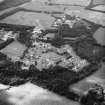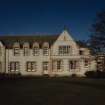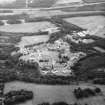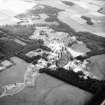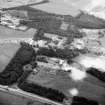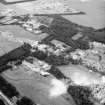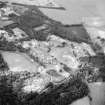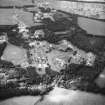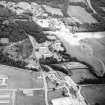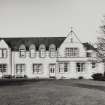Pricing Change
New pricing for orders of material from this site will come into place shortly. Charges for supply of digital images, digitisation on demand, prints and licensing will be altered.
Dechmont, Bangour Village Hospital, Villa 8
Psychiatric Hospital (20th Century)
Site Name Dechmont, Bangour Village Hospital, Villa 8
Classification Psychiatric Hospital (20th Century)
Canmore ID 248432
Site Number NT07SW 18.06
NGR NT 03185 70923
Datum OSGB36 - NGR
Permalink http://canmore.org.uk/site/248432
- Council West Lothian
- Parish Ecclesmachan
- Former Region Lothian
- Former District West Lothian
- Former County West Lothian
2-storey with breaking-eaves dormers, 6- by 4-bay, Roughly L-plan, gabled, restrained Scots Renaissance style hospital villa. Painted roughly coursed and snecked sandstone with contrasting ashlar margins and alternate quoins. Base course, cornice. Round-arched dormer heads. Shouldered gables, some with small slit windows openings to apex. Some bipartite windows. Canted window at ground to W. Flat-roofed extension to E. S elevation with advanced flat-roofed windowed bay at ground to left.
Bangour Village Hospital is the best surviving example in Scotland of a psychiatric hospital created in the village system of patient care, a revolutionary concept in the late 19th century. This is one of a group of 4 four villas which are situated around the former administration building (see separate listing) of the complex. The villa has some plain Renaissance detailing in the round-arched dormerheads, ridge tiling and contrasting colour in the building materials (although later painted and rendered) and it is a significant component of the overall integrity of the site. Built in a restrained Scots Renaissance style, it was used initially as accommodation for patients who required close supervision.
The buildings of the hospital sit within their original rural setting and remain largely externally unaltered. There were originally 8 of these closed villas proposed, but only 4 were built. 2 styles were used for them and this one is in a similar style to Villa No 10 (see separate listing). There were single rooms in some of these villas, there was 2 padded rooms if required. These are mentioned by the architect as being the only padded rooms in the whole complex. The villa originally had a verandah to the SW.
Designed in a restrained Scots Renaissance style, Bangour Village Hospital is an outstanding remaining example of a psychiatric hospital built as a village and espousing a complete philosophy of care. The village system of patient care, exemplified by the Alt-Scherbitz hospital, near Leipzig in Germany in the 1870s encouraged psychiatric patients to be cared for within their own community setting, where there were few physical restrictions and where village self-sufficiency was encouraged. This was in contrast to the large contemporary asylum buildings. This philosophy had been gradually developing in a number of Scottish institutions, but Bangour saw its apotheosis, specifically in relation to psychiatric patients. Two other hospitals were built in Scotland for psychiatric patients, Kingseat, to the north of Aberdeen (built in 1904) and Dykebar Hospital in Paisley, 1909 (see separate listing). These have not survived as completely as Bangour.
The hospital was built by the well-known Edinburgh architect Hippolyte J. Blanc as a result of a competition begun in 1898 and was the first of the new thinking in psychiatric provision to be conceived in Scotland. The Edinburgh Lunacy Board had concluded that a new psychiatric hospital was required to cater for the increasing numbers of patients from Edinburgh and the hospital was opened in 1906, with some of the buildings still to be completed. It was designed with no external walls or gates. The utility buildings were positioned at the centre of the site, the medical buildings for patients requiring medical supervision and treatment were to the E and there were villas to the W of the site which could accommodate patients who required less supervision and were able to work at some sort of industry. The complex also included a farm to the NW (not part of current site) and had its own water and electricity systems and also had its own railway. The hospital was commissioned by the War Office in WWI for wounded soldiers and extra temporary structures were erected. Most of which were dismantled after the War although some timber ones were retained by the hospital. The railway too was dismantled in 1921. The patients returned in 1922. The hospital was commissioned again for WWII. At this time many temporary shelters were erected to the NW of the site and this became the basis of the Bangour General Hospital (now demolished). Bangour Village Hospital continued as a psychiatric hospital until 2004.
Hippolyte J. Blanc (1844-1917) was an eminent and prolific Edinburgh-based architect who was perhaps best known for his Gothic revival churches. He was also a keen antiquarian and many of his buildings evoke an earlier Scottish style.
List description revised, 2011. Villa formerly listed at category A as part of a single listing covering Bangour Village Hospital. Category changed to C(S) following listing review, 2011. (Historic Scotland)

















